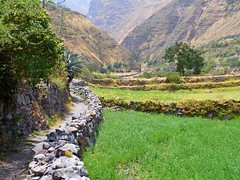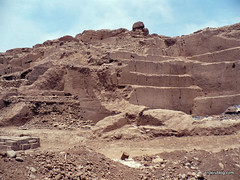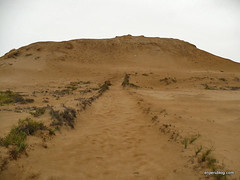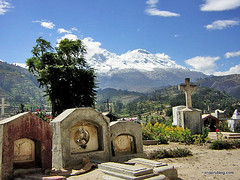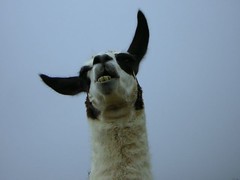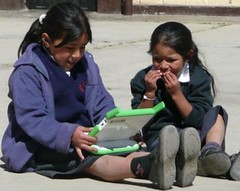Above the Inca capital of Cusco (Q’osco) sits the important ceremonial site and one of human-kinds most impressive constructions called Sacsayhuamán, which despite its global fame still offers up secrets to investigators. Yesterday the discovery was announced of three burials, one of which contained the severed heads of the Inca’s enemies.
Category: "Archaeology"
Priestess of Cahuachi
Tomb discovered of an elite child dating to the early Nasca Period. With the mummy were various pieces of jewellery made from gold, silver and precious stones.
Paying for a guardian out of his own pocket for 27 years turned out to be worth it for the Italian archaeologists Giuseppe Orefici, director of the Nasca Project. Not reimbursed by his supervisors in Italy nor (shamefully but all too predictably) by the Peruvian state, it is thanks to the Italian’s dedication at the heavily tomb-raided ceremonial city of Cahuachi, a expansive adobe city of countless buried pyramids, that a recent discovery was able to be made.
Youngest Moche noble yet at Sipán site
Two thousand years ago, a young man was buried in the royal mausoleum next to a huge and brightly decorated Moche pyramid, now known as the Huaca Rajada, at the site of Sipán. Studies have been conducted on this recent discovery that have determined his age at time of death to be just 21, making him the youngest Moche noble yet found.
Twelve Cañaris tombs discovered in Lambayeque
Félix López Reyes has spent a large part of his life guarding the 35 hectares that he owns half way up El Gallo in the mountainous border region between Lambayeque and Piura, 2500 metres above sea level and 8 hours walk from El Sauce in the district of Cañaris in the province of Ferreñafe. However, it wasn’t until very recently that he realised that on his property was something more valuable to guard than his coffee beans and cows. Here a discovery has been made that may help us learn more about the Cañaris people.
Ñain An sculptures: New secrets revealed at ancient Chan Chan
The discovery of 17 wooden statues at Chan Chan are enough to change our understanding of the Chan Chan urban centre. Embedded in the walls of the later Ñain An complex, also known as Bandelier, the figures are thought to have bid farewell to the deceased leaders.
Lady of Pacopampa: A woman born to rule
After three years of work in the town of Pacopampa, a team of archaeologists led by Yuji Seki have found the outlines of an ancient temple that would have formed part of a larger complex located 20 minutes from the modern town of the same name. But far more impressive is what they’ve found buried inside the temple. The team discovered the tomb of a woman, whose social position quickly became evident.
Ollantaytambo: A living breathing Inca town
This pretty little town in the Andes is different from all the others. It may be set among beautiful mountainous scenery like all the others, be populated by indigenous locals going about their daily business like all the others, be pleasantly quiet like all the…
Ancient pre-Incan city discovered high above the Zaña river
Located between the Peruvian regions of Lambayeque and Cajamarca, the ancient site, according to famed archaeologist Walter Alva, appears to be shrouded in vegetation.
Peruvian archaeologist Walter Alva, the man who has made some of the most prominent archaeological discoveries in the past decades such as the world-headlining remains of the Lord of Sipán, has received word of an exciting new discovery in the mountains of the same region.
Housewives restore walls of ancient Chan Chan
The ancient capital of the Chimor Kingdom, the grand city of Chan Chan, has been in the news recently for all the wrong reasons. After 500 years of abandonment in the desert outside Trujillo, it has been damaged by 500 yearly rains that have washed away large parts of the walls of the adobe city. Restoration has been under way for years, but with limited resources it is a slow process. The site needs all the help it can get to avoid deteriorating more – that’s where the housewives come in.
Terraces of Moray
Some say Moray was an Inca laboratory used to test how different crops would perform at different temperatures. Others say it was a more of a nursery where crops were bred and cross-bred, varieties created and new foreign crops tested. A third group say it was just an ingenious means to grow warmer climate maíz or corn in the local cold climate. Whoever is right, this archaeological site of concentric circles of terraced farms, forming craters in the landscape, are a fascinating sight to behold.
Across from Ollantaytambo
When I first visited the ruins of Ollantaytambo, I saw the Inca store houses up on the other side of the valley across the town. There’s no way I could have climbed up there back then, I was just too exhausted. I figured I’d visit them “next time”, whenever that would be. A couple of years passed, and “next time” finally came.
Inca Pisaqa – The ruins of Pisac
High above the colonial market town of Pisac, today the gateway for many tourists to the Sacred Valley, are some of the finest Inca ruins in existence. They might not be in a location quite as beautiful as Machu Picchu, or on a scale quite as monumental as Sacsayhuamán, but the stonework here is some of the best you will ever see in Peru or elsewhere. Spanning about a kilometre or two along a mountain ridge at 3250 metres above sea level, its sections are separated by natural terrain but accessible by paths and tunnels. As you march from one urban area to another along these paths, with steep drops all the way, you can’t help but be awestruck by it all.




